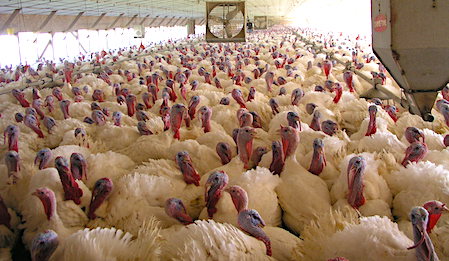
By Sarah Vogelsong, environment and energy reporter for Virginia Mercury
Virginia farmers and agriculture officials are bracing themselves after a highly pathogenic strain of avian influenza known as the Eurasian H5 type was detected in a flock of chickens and turkeys in Fauquier County this February.
“We’re very worried,” said Hobey Bauhan, president of state industry group the Virginia Poultry Federation. An outbreak “would be devastating economically,” he added.
Virginia’s last major outbreak of the virus in 2002 affected 197 farms in the Shenandoah Valley and resulted in the culling of more than 4.7 million turkeys and chickens. In 2007, officials detected avian influenza in a single turkey flock in Mt. Jackson, but no other cases were reported.
“In 2002, it got out of hand and spread a lot before people really knew how bad it was,” State Veterinarian Charles Broaddus told the Virginia Board of Agriculture and Consumer Services Thursday. “But now we have a plan, and the plan we hope will be able to contain it to a smaller area before it’s spread that far.”
Virginia Commissioner of Agriculture and Consumer Services Joseph Guthrie said an emergency order has been drafted and sent to Gov. Glenn Youngkin in the event that cases increase.
“Thankfully we have not had to use that yet, but we are prepared,” he said.
Avian influenza is typically spread by the feces of wild waterfowl who act as carriers. The virus can survive more than 35 days in manure, soil and water and several months in colder conditions.
Scientists first detected the current strain’s presence in Virginia in four wild birds caught by hunters. Because of its location along the Atlantic Flyway — one of the major north-south routes followed by migratory birds winging south from Canada — the state regularly sees large numbers of wild species that are capable of transmitting disease to domestic populations.
As of Thursday, the H5 strain had been detected in wild waterfowl in 24 states and in poultry or backyard flocks in 17 states, causing fears nationwide among farmers and poultry processors.
While avian influenza hasn’t shown signs of being transmissible to humans, its economic impacts can be severe. Highly pathogenic strains like the one that has emerged this winter can kill large numbers of birds directly while also spreading rapidly within and between flocks.
In the state’s single outbreak recorded so far, 20 out of 40 chickens and seven of 17 turkeys in a backyard flock in Fauquier County succumbed to the virus.
After the owner called state officials to the property Feb. 11, samples were sent to state and federal laboratories. The state’s Harrisonburg lab confirmed the presence of the H5 strain that day, with federal scientists corroborating the findings the next day. The state then swiftly euthanized the remaining members of the flock.
“The birds are essentially virus factories, replicating and producing millions of virus particles all the time, so if we can reduce that it’s better for reducing the transmission of the virus to other species,” said Broaddus.
In 2020, Virginia was the United States’ sixth-largest producer of turkeys and the 10th-largest producer of broiler, or meat, chickens. Broilers are also Virginia’s top agricultural commodity, responsible for $625 million of cash receipts in 2020.
The Shenandoah Valley alone is home to roughly 250 turkey farms and 550 chicken farms, according to figures provided by the Virginia Department of Agriculture and Consumer Services. The Eastern Shore, where Tyson Foods and Perdue Farms operate large processing plants, has also become a major producer of poultry.
Besides killing birds, avian influenza cases risk triggering trade bans by other countries. In January 2015, China imposed a ban on U.S. poultry after the nation experienced its largest ever outbreak, which affected midwestern and western states but never reached the East Coast. The ban wasn’t lifted until late 2019.
To date, several countries, including Mexico, have placed restrictions on imports of poultry from states with avian flu cases, including Virginia.
Following the 2002 outbreak, Virginia formed a Poultry Disease Task Force that includes federal, state and industry representatives. Since the February case was reported, the group has been in close communication and conducted a tabletop exercise to simulate potential outbreak pathways and responses, said Bauhan.
Virginia also has a state plan to prevent and respond to any avian flu cases that was developed by the task force after 2002 and has been periodically updated.
That plan “was designed to prevent and respond to the more likely scenario of another” low-pathogenic avian influenza outbreak “rather than an outbreak of” highly pathogenic avian flu, the document notes.
Bauhan said “the basic responses are very similar,” however.
“The biosecurity protocols are all going to be the same,” he said. “The USDA typically takes more of the lead in a highly pathogenic outbreak, but still working very closely with state veterinarians and the poultry industry.”
Farmers are being urged to take steps such as limiting visitors to their poultry houses, increasing disinfection protocols and establishing a “line of separation” between areas where flocks are kept and the outside world.
Further spread is “not inevitable,” said Broaddus.
“There are steps that can be taken to reduce the risk,” he said. “But are we at much higher risk than usual this year? Yes, we are.”
Republished from VirginiaMercury.com with permission
through Creative Commons license CC BY-NC-ND 4.0
•••
RELATED ARTICLES
Future of farming in Page, a work in progress
Extension Office seeks vendors for weekly farmers market at PMH June through October
Poultry processor investing $31.5M to set up first East Coast operation in Winchester
Virginia remains an important turkey-producing state



Be the first to comment